A Newsletter from the Minnesota Department of Agriculture
|
|
|
June 4, 2019
Emerald Ash Borer Active Flight Period
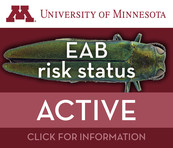
The Minnesota Department of Agriculture's emerald ash borer (EAB) best management practice guidelines say to avoid removal of ash branches, trees and stumps May 2 through September 30 in known emerald ash borer infested areas.
If removal is necessary due to a hazardous condition then chip at least the outer 1" of bark/wood on-site and transport to the nearest facility that can quickly process the material or transport at least the outer 1" of bark/wood in a vehicle where it is 100 percent enclosed to the nearest facility that can quickly process the material. Material should remain enclosed until it can be at a minimum chipped.
For more information on best management practices please visit the MDA EAB website or the University of Minnesota EAB risk status website.
|
|
|

Palmer Contamination in Screenings for Feed
The most recent finds of Palmer amaranth in Minnesota were in late summer 2018 when very small infestations were discovered in Redwood and Jackson County crop fields. Work to discover the source of the infestation in Redwood County eventually led to manure from cattle fed sunflower screenings contaminated with Palmer amaranth seed. Screenings are what remain after grain or seed is cleaned of other plant debris and seeds and are often used as a feed component for livestock. This find prompted the MDA to take a closer look at screenings and additional detections of Palmer were made including another in sunflower screenings and one in wheat. During 2019, the MDA will be working to sample many different sources and types of screenings to better identify where the greatest risks are for Palmer contamination and to help producers catch this problem before it gets into their fields.
Read more
|

Gypsy Moth Treatments
The MDA completed two gypsy moth treatment areas in the Twin Cities greater metro area at the end of May. The Lakeville treatment area covered 133 acres including a portion of Credit River Township. The Stillwater treatment area covered 633 acres in the southwest corner of the city. A 135 acres treatment in eastern Chisholm is planned for June.
The MDA conducts an extensive monitoring survey for gypsy moth each year as part of the national Slow the Spread Program. The survey identifies areas where gypsy moth populations are building and can be knocked back or eradicated with treatments.
Read More
|
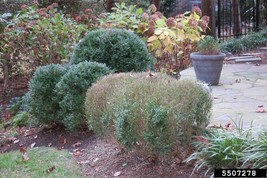
Boxwood Blight in Minnesota
Boxwood blight, Calonectria pseudonaviculata, has not been found in Minnesota but it has been found in neighboring Wisconsin. An alert from the Wisconsin Department of Agriculture Trade and Consumer Protection (DATCP) regarding the discovery of the disease at a retail site in Madison, Wisconsin prompted follow-up at sites in Minnesota that received boxwood from the same Ohio source. Samples were taken to the University of Minnesota Plant Disease clinic and were found to be infected with Volutella blight which is very common in Minnesota and not a significant foliar disease. Boxwood blight is very destructive and there is no practical control other than destroying infected plants and using clean plant practices. Thus far no reports of boxwood blight have been made. Nursery Inspection staff will continue to look into possible introductions and inspect boxwood plants in retail sites.
Read More
|

Protecting Minnesota's Resources
A wide variety of surveys are occurring statewide this summer to look for invasive pests to protect Minnesota's resources. You may notice the MDA setting insect traps for gypsy moths, looking for insects and diseases in community gardens or forested areas, and trapping for brown marmorated stink bugs (BMSB) in apple orchards. Invasive pest surveys will also be conducted in vineyards, CSAs, corn, small grain, and soybean fields. The MDA also surveys for parasitoid wasps that help manage invasive insects like EAB and BMSB. In addition to invaisve plant pests, the MDA samples apiaries for the National Honey Bee Survey.
For more information about these surveys, contact the MDA at arrest.the.pest@state.mn.us.
|
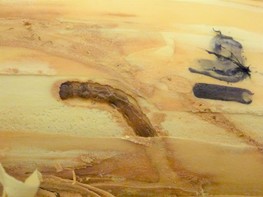
Emerald Ash Borer Winter Mortality
While winter temperatures are not low enough to have a substantial impact on emerald ash borer (EAB) every year in Minnesota, during the past winter they were. The MDA assessed winter impacts on EAB during sampling efforts this spring at Fort Snelling State Park, Sauk Centre and Duluth. Many larvae were visibly discolored and dead at the point of sampling (see picture). Larvae that appeared healthy and were not injured during sampling were removed from trees and held in a warm area. Over a period of a few days the larvae were periodically prodded and any that moved at some point were counted as alive, any larvae that failed to move at any point were counted as dead. Based on the data we estimate the following levels of EAB mortality at these sites (temperature estimates from MN DNR Climate Data, www.dnr.state.mn.us/climate/index.html):
- 82-99% EAB mortality at Sauk Centre, air temperature dropped below -30 degrees Fahrenheit
- 67-89% EAB mortality at Duluth, air temperature dropped below -30 degrees Fahrenheit
- 40-86% EAB mortality at Fort Snelling, air temperature dropped below -20 degrees Fahrenheit
The low end of each estimate is the percentage of larvae that were visibly discolored and dead, the high end includes the larvae that were not discolored but did not move while being held under warm conditions.
The last time cold weather had such a significant impact on EAB in Minnesota was during the 2013/2014 winter when an estimated 60-70% of larvae were killed in the Twin Cities area. While the occasional cold winter is probably helping to slow the spread of EAB in Minnesota and delay impacts for infested areas, cold temperatures do not solve the problem. In each infested area, at least some portion of the population survived and populations will quickly rebound over the next couple years if we don’t see the same cold temperatures.
Read more
|
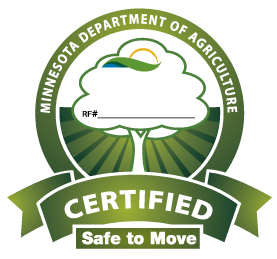
The Minnesota Department of Agriculture has certified nine firewood producers in the state of Minnesota for heat treatment of firewood. Look for the logo when purchasing firewood. It means the firewood is safe to move and is free of emerald ash borer.
Certified firewood producers:
- Emily Forest Products
- JN Firewood
- Minnesota Firewood LLC
- Paul's Fireplace Wood Inc.
- Price Firewood
- Sunset Firewood Company
- TSL Firewood
- Wood Chuckers Firewood LLC
- Leroy Habiger "The Firewood Man"
|
|
|
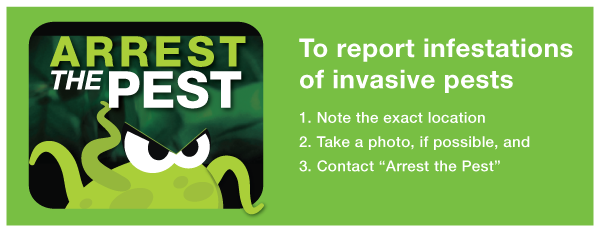 Call us at 888-545-6684
Email us at arrest.the.pest@state.mn.us
|
|